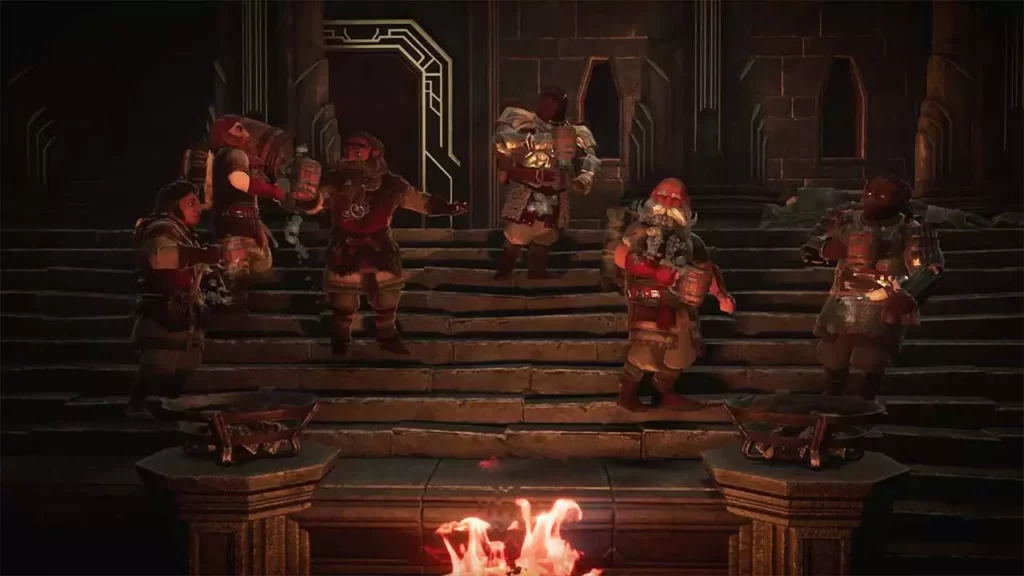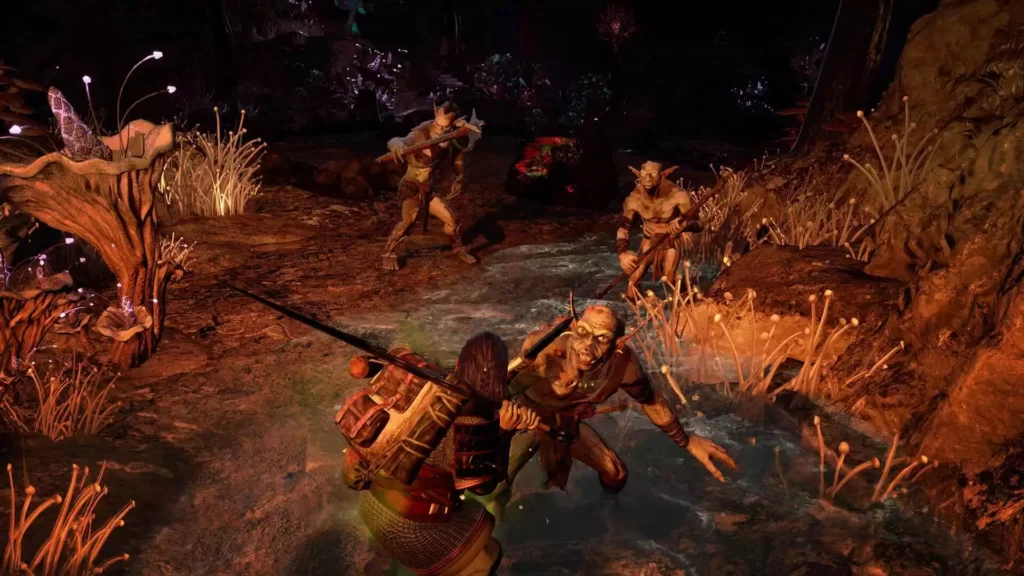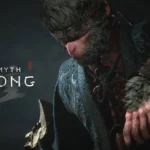The Lord of the Rings: Return to Moria is undeniably a loving homage to one of the most iconic fantasy worlds ever created. However, to my surprise, its most recognizable aspect isn’t its Tolkien-inspired setting. In reality, this game prioritizes survival elements over its Lord of the Rings identity. It relies on conventional mechanics of the survival genre while heavily leaning on its Tolkien-themed backdrop to compensate for a lack of original concepts.

If you’ve had any experience with survival games over the last 15 years, you’ll find yourself right at home. You’ll engage in activities like building bases, cooking food, upgrading your tools for better resource gathering, crafting weapons and armor to fend off enemy hordes, and rushing back to safety when night falls. The issue lies in the fact that Return to Moria doesn’t excel in any aspect of the well-worn survival blueprint, often falling short of games that came before it. Furthermore, it falters in areas such as combat mechanics and restrictive building, which are notably inferior to many of its counterparts in the genre.
Returning to Moria’s Story

The Lord of the Rings Online: Return to Moria unfolds during Middle-earth’s Fourth Age, a relatively unexplored era in the canon, after the fall of Sauron and the conclusion of the War of the Ring. Gimli, the beloved dwarf, voiced by the movie trilogy’s actor John Rhys-Davies, has summoned all the dwarf factions to retake Moria from the goblins and orcs that have overrun it. As one of these summoned dwarves, you and up to seven companions embark on a perilous journey to reclaim the lost kingdom. Your adventures in Moria involve seemingly mundane tasks like cooking rat meat, hastily assembling hovels, and managing a plethora of materials stored in scattered chests.
ALSO READ: TESTAMENT THE ORDER OF HIGH HUMAN – A COMPREHENSIVE REVIEW OF THE FRUSTRATING FANTASY RPG
The story builds up to a confrontation with a powerful entity that has corrupted Moria with dark magic. However, the story often feels like a series of excuses to reference events from The Fellowship of the Ring, frequently alluding to the moments when the Fellowship passed through various locations. While the story isn’t necessarily poor, it plays a secondary role in a game that primarily involves traversing dark corridors and battling goblins. During the course of my journey, which lasted nearly 45 hours, it was easy to forget the overarching plot due to the extensive focus on exploration and combat.
Melodic Echoes of Middle-earth in The Lord of the Rings: Return to Moria

Occasionally, Return to Moria lovingly reminds you that you’re in Middle-earth through the power of song. Fans of Tolkien’s works know that the man had a penchant for weaving melodies into his tales, and this game pays a delightful tribute to that legacy. While mining various ores, your dwarf character will spontaneously burst into song from a vast library of light-hearted tunes. If you happen to share a drink with your comrades, the merriment takes the form of dancing and singing epic ballads about your people’s history. Moreover, during pivotal story moments, you’ll engage in particularly stirring songs infused with lore and heartfelt emotion. However, these musical interludes might be interrupted by goblins and orcs attempting to attack you during your impromptu performances, as was the case for me on multiple occasions.
ALSO READ: ARCADIAN ATLAS REVIEW – A CAPTIVATING SRPG ADVENTURE WITH LOVE, WAR, AND UNIQUE COMBAT SYSTEMS
What The Lord of the Rings: Return to Moria truly excels at is the rhythmic pattern of gathering increasingly valuable resources to satisfy your growing base-building requirements. The cycle of delving deeper into a perilous mine infested with monsters, all while collecting resources and enhancing your character, proves to be engaging. Initially armed with a simple pickaxe and sword, you soon discover that more formidable enemies lurk in the depths, and therein lies the challenge. To overcome these foes, you must obtain rarer raw materials, upgrade your equipment, and enhance your base’s amenities, such as a keg filled with beer to boost morale—an essential addition. It’s easy to become engrossed in this ongoing grind, constantly striving for the next valuable resource that will empower you to tackle the next leg of your journey. This loop will feel familiar to anyone who has lost track of time while exploring in Minecraft or battling giant spiders in Grounded. While it doesn’t break new ground, Return to Moria successfully treads upon well-worn territory, delivering an enjoyable experience.
Freedom and Frustration in The Lord of the Rings: Return to Moria

The world of Return to Moria is a generally enjoyable grind, offering building, combat, and exploration. However, all these elements share a common flaw: a startling lack of freedom. While the game allows you to establish a base from the ground up almost anywhere, each new zone features one or two preset campsites that offer significant advantages as starting points. This makes it challenging to justify investing resources in creating a camp elsewhere. Even when I attempted to break free from the norm and settle in a location of my choosing, I often found the building options frustratingly finicky, leading to regrettable undertakings. For instance, I spent half an hour trying to construct a second story for my base, which kept collapsing due to unspecified load-bearing structure rules. In another case, I realized the area I had selected was diagonally oriented on the grid-based map, rendering all the structures I placed incompatible with the room’s layout. It feels as though the designers went to great lengths to deter players from establishing their own settlements, an odd set of priorities for a game centered on rebuilding Moria.
Worse yet is the combat, a mundane routine of blocking, stabbing, or shooting arrows with only a few weapon types that feel too similar. This is a significant letdown, considering that The Lord of the Rings: Return to Moria requires a substantial amount of combat. Goblins, orcs, and uruks spawn across the map whenever you’re not looking, assemble an army to retaliate against your noisy mining and exploration, and frequently assault your bases with destructive intentions. Many of these encounters can drag on for 15 to 20 minutes, with hordes of identical foes constantly respawning. Combat isn’t particularly challenging because the enemy AI is astonishingly inept. However, due to their sizable health bars and a steady stream of incoming attacks that forced me to dodge and block more often than attack, these battles felt needlessly protracted.
The quality of the enemy AI cannot be overstated—it’s simply bad. Enemies frequently become stuck within their surroundings, allowing you to stand at a safe distance and eliminate them with ranged attacks. They repeat the same attacks, enabling you to use the same countermove a dozen times before they finally succumb. Occasionally, you encounter new enemy types like drakes or trolls, but even these foes fall prey to the game’s abysmal AI, extinguishing any excitement quickly.
Dwarven Scream and Imposed Mining Limits in Return to Moria
In The Lord of the Rings: Return to Moria, the constant and obnoxious noise made by enemies can quickly wear on players’ nerves. These foes scream and holler incessantly, and even when you’re not in close proximity to them, you can hear their manic clamor. After more than 40 hours of this audio assault, I found myself on the brink of letting out a psychotic scream of my own.
The game also makes an odd choice by not permitting unrestricted mining. Instead, it erects hard, impenetrable barriers all over the place and confines mining to narrow hallways that connect various areas. In contrast, games like No Man’s Sky and Ark have maintained their appeal because they offer limitless ways to shape the world, create intriguing bases, and express your creativity. Return to Moria lacks this freedom, even limiting mining to small deposits on the sides of mine halls. You’ll dig out these shallow deposits only to encounter another unbreakable barrier, leaving you unable to dig through much of anything in a game that’s supposedly set in a mine.
Nevertheless, the environments you traverse through exhibit plenty of personality. From the beautiful Elven Quarter filled with trees to the grim depths shrouded in glowing mushrooms and a noxious corruption, these areas add character to the experience. This is one of the few ways in which Return to Moria distinguishes itself from its peers. Journeying through the linear paths of this underground kingdom evokes the essence of a genuine Lord of the Rings adventure. While it may not stand out as extraordinary, I still enjoyed the rewarding process of developing my base, enhancing my equipment, and venturing deeper underground to face the unknown. It does make the journey somewhat more linear than the typical survival game, but it channels the tradition of Tolkien’s adventures that take heroes on perilous journeys from one part of Middle-earth to another. It feels just right.
Troublesome Performance and Improved Fun with Friends in The Lord of the Rings: Return to Moria
Performance issues plague Return to Moria, detracting from the overall gaming experience. The game suffers from various bugs such as items mysteriously disappearing, unstable frame rates, and uncharacteristically long loading times. In extreme cases, areas sometimes fail to load properly, revealing immersion-breaking developer objects like walls separating different parts of the map. These walls don’t vanish until you get uncomfortably close to them. Notably, there are only a few instances where Return to Moria looks and performs acceptably. Strangely, performance worsens when additional players join a world, particularly for guests. So, if you host the game, expect your friends to experience even worse performance.
Despite its performance woes, The Lord of the Rings: Return to Moria shines when enjoyed with friends. No Lord of the Rings tale is complete without a party of companions to share the adventure with. Having multiple players in your world may increase chaos, with four or five friends breaking objects and battling wolves. This amplifies the need to provide for the group, ensuring everyone has enough gear and food. However, large combat encounters are notably quicker and more manageable with a group. Furthermore, having others around proves beneficial when you need assistance or someone to help carry the loot you can’t fit in your backpack. Yet, as mentioned earlier, adding more players also compounds the game’s performance issues.
The Verdict
The Lord of the Rings: Return to Moria offers a unique blend of Tolkien-inspired storytelling and survival gameplay. While it captures the essence of Middle-earth and provides an engaging resource-gathering and base-building experience, it falls short in several key areas. Combat is repetitive and hindered by lackluster enemy AI, and the game’s restrictions on mining and settlement building limit player creativity. Furthermore, performance issues can detract from the overall gaming experience, particularly in multiplayer. While it has its moments and can be enjoyable, there are more compelling options available in both the survival and Lord of the Rings genres, making Return to Moria a somewhat underwhelming choice, even for die-hard Tolkien enthusiasts.
FAQs of The Lord of the Rings: Return to Moria
Q1: What is The Lord of the Rings: Return to Moria, and how does it approach the survival game genre?
A1: The Lord of the Rings: Return to Moria is a game set in the Tolkien-inspired universe of Middle-earth. It combines elements of the survival game genre, involving activities like building bases, cooking food, upgrading tools, crafting weapons and armor, and resource gathering. However, it is suggested that it prioritizes survival gameplay over its Lord of the Rings identity, relying on conventional survival mechanics with a Tolkien-themed backdrop.
Q2: How does the game’s story in Return to Moria fit within Middle-earth lore, and what is the main objective of the player’s character?
A2: Return to Moria takes place during Middle-earth’s Fourth Age, after the fall of Sauron and the War of the Ring. Players assume the role of one of the dwarves summoned by Gimli to reclaim the overrun kingdom of Moria from goblins and orcs. The game’s story frequently references events from The Fellowship of the Ring but mainly involves exploration and combat.
Q3: What are some unique features of Return to Moria that pay homage to Tolkien’s works, and how do they impact the gameplay?
A3: The game incorporates musical elements inspired by Tolkien’s legacy, with the player’s dwarf character spontaneously bursting into song while mining and sharing merriment with companions through dancing and singing. This adds an immersive and thematic touch to the gameplay. The game also focuses on a progression loop involving resource gathering, character improvement, and base-building.
Q4: What challenges or limitations are highlighted in Return to Moria, particularly regarding freedom and gameplay elements?
A4: A lack of freedom in base-building and limited freedom for players to establish their own settlements. Building options are noted as finicky, and the grid-based system can lead to regrettable undertakings. The combat is described as monotonous and repetitive, with enemy AI that is lacking in challenge. The game imposes restrictions on mining and doesn’t offer limitless ways to shape the world.
Q5: How does multiplayer gameplay affect Return to Moria, and what performance issues players will face in game?
A5: Playing with friends in a multiplayer setting can increase chaos but also make large combat encounters more manageable. However, additional players can exacerbate the game’s performance issues. Technical problems like items disappearing, unstable frame rates, long loading times, and areas failing to load properly.






